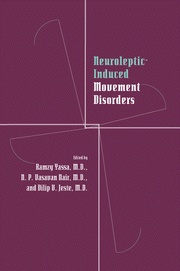Book contents
- Frontmatter
- Contents
- Contributors
- Preface
- Part I Historical perspective
- Part II Clinical aspects of tardive dyskinesia
- Part III Mechanisms underlying tardive dyskinesia
- 11 Neurochemistry of the basal ganglia
- 12 A reanalysis of the dopamine theory of tardive dyskinesia: the hypothesis of dopamine D1/D2 imbalance
- 13 Tardive dyskinesia and phenylalanine metabolism: risk-factor studies
- 14 Neuroendocrinological studies of tardive dyskinesia
- 15 Cognitive deficits and tardive dyskinesia
- 16 Studies of tardive dyskinesia using computed tomography and magnetic-resonance imaging
- 17 Rodent and other animal models of tardive dyskinesia during long-term neuroleptic-drug administration: controversies and implications for the clinical syndrome
- Part IV Measurement of tardive dyskinesia
- Part V Tardive dyskinesia in different populations
- Part VI Other neuroleptic-induced movement disorders
- Part VII Treatment of tardive dyskinesia
- Index
12 - A reanalysis of the dopamine theory of tardive dyskinesia: the hypothesis of dopamine D1/D2 imbalance
from Part III - Mechanisms underlying tardive dyskinesia
Published online by Cambridge University Press: 09 October 2009
- Frontmatter
- Contents
- Contributors
- Preface
- Part I Historical perspective
- Part II Clinical aspects of tardive dyskinesia
- Part III Mechanisms underlying tardive dyskinesia
- 11 Neurochemistry of the basal ganglia
- 12 A reanalysis of the dopamine theory of tardive dyskinesia: the hypothesis of dopamine D1/D2 imbalance
- 13 Tardive dyskinesia and phenylalanine metabolism: risk-factor studies
- 14 Neuroendocrinological studies of tardive dyskinesia
- 15 Cognitive deficits and tardive dyskinesia
- 16 Studies of tardive dyskinesia using computed tomography and magnetic-resonance imaging
- 17 Rodent and other animal models of tardive dyskinesia during long-term neuroleptic-drug administration: controversies and implications for the clinical syndrome
- Part IV Measurement of tardive dyskinesia
- Part V Tardive dyskinesia in different populations
- Part VI Other neuroleptic-induced movement disorders
- Part VII Treatment of tardive dyskinesia
- Index
Summary
Today, more than 30 years after the first descriptions of neuroleptic-induced involuntary movements (Schonecker, 1957; Uhrbrand & Faurbye, 1960), a definitive understanding of the pathophysiology of the syndrome is lacking. In fact, the very number of theories offered to explain the basis of tardive dyskinesia is testimony to the absence of a fundamental, unifying explanation for the propensity of neuroleptics to induce tardive dyskinesia. Indeed, it remains uncertain that there ever will be one unifying explanation.
The classic explanation of the pathogenesis of tardive dyskinesia is the dopamine-hypersensitivity theory (Klawans & Rubovits, 1972; Tarsy & Baldessarini, 1973). According to this theory, chronic blockade of the postsynaptic dopamine receptors by neuroleptics results in adaptive dopamine-receptor hypersensitivity and cholinergic hypofunction, changes that result in chronic dyskinesia. Acute dyskinesia, on the other hand (i.e., dyskinesia occurring at the onset of dopamine blockade), has been believed to be a direct result of the dopamine blockade itself (i.e., acute dopamine hypofunction and cholinergic hyperfunction) (Gerlach, 1979). Because further development of the dopamine-hypersensitivity theory has focused mainly on the examination and manipulation of dopamine D2 receptors in rodents, it could more properly be termed the dopamine D2-hypersensitivity theory of tardive dyskinesia. In recent years, this theory has been criticized for lack of confirmation of its postulates in humans (Fibiger & Lloyd, 1984; Gerlach, 1985; Casey, 1991).
We intend to reanalyze the role of the dopaminergic system in the pathogenesis of tardive dyskinesia.
- Type
- Chapter
- Information
- Neuroleptic-induced Movement DisordersA Comprehensive Survey, pp. 141 - 160Publisher: Cambridge University PressPrint publication year: 1996
- 2
- Cited by



